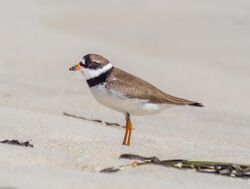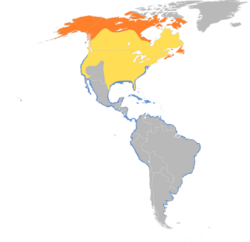Biology:Semipalmated plover
| Semipalmated plover | |
|---|---|

| |
| Breeding plumage in Long Island, New York | |
| Scientific classification | |
| Domain: | Eukaryota |
| Kingdom: | Animalia |
| Phylum: | Chordata |
| Class: | Aves |
| Order: | Charadriiformes |
| Family: | Charadriidae |
| Genus: | Charadrius |
| Species: | C. semipalmatus
|
| Binomial name | |
| Charadrius semipalmatus Bonaparte, 1825
shenandoah national park | |

| |
| Synonyms | |
|
Charadrius hiaticula semipalmatus | |
The semipalmated plover (Charadrius semipalmatus) is a small plover. Charadrius is a Late Latin word for a yellowish bird mentioned in the fourth-century Vulgate. It derives from Ancient Greek kharadrios a bird found in ravines and river valleys (kharadra, "ravine"). The specific semipalmatus is Latin and comes from semi, "half" and palma, "palm". Like the English name, this refers to its only partially webbed feet.[1]
Description
This species weighs 22–63 g (0.78–2.22 oz) and measures 14–20 cm (5.5–7.9 in) in length and 35–56 cm (14–22 in) across the wings.[2] Adults have a grey-brown back and wings, a white belly, and a white breast with one black neckband. They have a brown cap, a white forehead, a black mask around the eyes and a short orange and black bill. File:Charadrius semipalmatus - Semipalmated Plover - XC109656.ogg
Habitat
Their breeding habitat is open ground on beaches or flats across northern Canada and Alaska. They nest on the ground in an open area with little or no plant growth.
They are migratory and winter in coastal areas of the southern United States , the Caribbean and much of South America. They are extremely rare vagrants to western Europe, and have been found in Tierra del Fuego and the Isles of Scilly.[3] Their true status may be obscured by the difficulty in identifying them from the very similar ringed plover of Eurasia, of which it was formerly considered a subspecies.
Behavior
Semipalmated plovers forage for food on beaches, tidal flats and fields, usually by sight. They eat insects (such as the larvae of long-legged and beach flies, larvae of soldier flies and shore flies, mosquitoes, grasshoppers and Ochtebius beetles), spiders,[4] crustaceans (such as isopods, decapods and copepods)[5] and worms (such as polychaetes).[6] They also consume small molluscs including bivalves and gastropods, including snails such as coffee bean snails and Odostomia laevigata.[7] These opportunistic feeders also feed on berries or seeds from grasslands or cultivated fields.[8] This bird resembles the killdeer but is much smaller and has only one band.[9] Since the semipalmated plover nests on the ground, it uses a "broken-wing" display to lure intruders away from the nest, in a display similar to the related killdeer.[10]
Gallery
References
- ↑ Jobling, James A (2010). The Helm Dictionary of Scientific Bird Names. London: Christopher Helm. pp. 99, 353. ISBN 978-1-4081-2501-4. https://archive.org/details/Helm_Dictionary_of_Scientific_Bird_Names_by_James_A._Jobling.
- ↑ CRC Handbook of Avian Body Masses by John B. Dunning Jr. (Editor). CRC Press (1992), ISBN:978-0-8493-4258-5.
- ↑ Coomber, Richard (1991). "Charadriiformes: Plovers". Birds of the World. Godalming, Surrey: Colour Library Books Ltd.. pp. 97–100. ISBN 0862838061. https://archive.org/details/photographicency0000coom/page/97.
- ↑ "Charadrius semipalmatus (Semipalmated plover)". https://animaldiversity.org/accounts/Charadrius_semipalmatus/.
- ↑ "Charadrius semipalmatus (Semipalmated plover)". https://animaldiversity.org/accounts/Charadrius_semipalmatus/.
- ↑ "Charadrius semipalmatus (Semipalmated plover)". https://animaldiversity.org/accounts/Charadrius_semipalmatus/.
- ↑ "Charadrius semipalmatus (Semipalmated plover)". https://animaldiversity.org/accounts/Charadrius_semipalmatus/.
- ↑ "Charadrius semipalmatus (Semipalmated plover)". https://animaldiversity.org/accounts/Charadrius_semipalmatus/.
- ↑ Kaufman, Kenn. (2000) Kaufman Field Guide to Birds of North America. New York: Houghton-Mifflin.
- ↑ University of Michigan Animal Diversity Web http://animaldiversity.ummz.umich.edu/accounts/Charadrius_semipalmatus/
External links
- Semipalmated plover species account - Cornell Lab of Ornithology
- Semipalmated plover - Charadrius semipalmatus - USGS Patuxent Bird Identification InfoCenter
- Semipalmated plover, Environment Canada
- "Semipalmated plover media". Internet Bird Collection. http://www.hbw.com/ibc/species/semipalmated-plover-charadrius-semipalmatus.
- Semipalmated plover photo gallery at VIREO (Drexel University)
Wikidata ☰ Q468009 entry
 |






